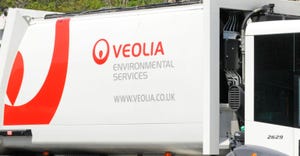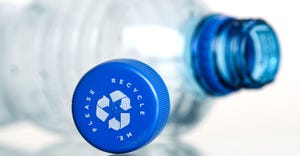The ABCs of Landfill ADCs
When it comes to choosing the right alternative daily cover, landfill operators have many options.
January 1, 2011
Jeffrey M. Fantell and Tom Flannagan
Municipal solid waste (MSW) landfill operators must cover all disposed waste at the end of each day to control odors, vectors, fires, litter and scavenging. Federal regulations require landfill operators to use a minimum of six inches of earthen materials as daily cover. Using soil as daily cover requires either excavating material from a borrow area at the landfill site or importing material from off-site.
While cover consisting of six inches of soil is effective in protecting human health and the environment, it does have some major drawbacks, including using up valuable airspace; the costs of excavating, loading and hauling on-site soil; the cost of procuring off-site soil; and impeding the movement of landfill gas and leachate.
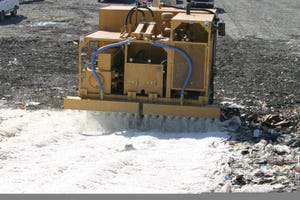 Fortunately, federal and state regulations allow for the use of alternative materials in lieu of earthen materials to cover waste at landfills. These materials are referred to as alternative daily covers (ADCs). In many states, if there is not already a pre-approved list of acceptable ADCs, some type of pilot program or demonstration period is required to gain approval for a specific type of ADC. It makes sense to get several types approved for your facility during this process, as no single type of ADC is ideal for all sites in all conditions.
Fortunately, federal and state regulations allow for the use of alternative materials in lieu of earthen materials to cover waste at landfills. These materials are referred to as alternative daily covers (ADCs). In many states, if there is not already a pre-approved list of acceptable ADCs, some type of pilot program or demonstration period is required to gain approval for a specific type of ADC. It makes sense to get several types approved for your facility during this process, as no single type of ADC is ideal for all sites in all conditions.
A landfill manager can choose from a large number of options of ADCs. Generally, ADCs can be classified as waste-derived materials and non-waste-derived materials. Waste-derived materials include ash, auto shredder fluff, construction and demolition (C&D) waste fines, compost, green waste such as vegetation and leaves, contaminated sediment and soil, sludge, and shredded tires. Non-waste-derived material can generally be classified into two groups: spray-on materials and geosynthetic materials or tarps.
Waste-Derived ADCs
One of the biggest advantages offered by waste-derived ADCs is that in many cases they can be a source of revenue for your facility. At a time when waste streams and related revenues are decreasing, getting paid to accept waste that you can then use as an ADC is an especially attractive option. Also, in some states, you may be able to count this material toward diversion, recycling or beneficial use goals. Depending on the state regulations, the following materials may be used as a substitute for soil cover, either on their own or after being blended with soil, typically in a 1:1 ratio.
• Ash. This ADC typically comes from the incineration of materials, such as the combustion of coal in energy generation. Ash can be used as-is or blended with soil or sludge. Given the U.S. Environmental Protection Agency’s recent focus on coal combustion by-products, this material may become a growing revenue source for landfill managers in the future.
• Auto shredder fluff. This material is the result of the process of shredding automobiles and recapturing the metals and plastics for reuse. Typically, the fluff is less dense than soil and is blended with soil prior to use.
• C&D waste fines. Fines are a soil-like material that is left over after C&D waste is processed for recycling. Normally, these fines would be disposed of in a landfill.
• Composted materials. These ADCs can consist of decomposed wood, green waste or other solid waste. If this material is not of sufficient quality to produce revenue, then its use as an ADC could be attractive.
• Green waste. This material is readily available at most landfills. Either ground or unground, this material can replace soil and also can be used as a substitute for gravel in maintaining roads and tipping pads.
• Contaminated sediment and soil. This material can be a great ADC. What better to replace clean soil, which has an associated cost to utilize, than soil that you get paid to take! Of course, run-off could be a concern depending on the contamination, and this material is not always available.
• Sludges. Sludges can be used as an ADC as there is often no other use for them. They can be attractive as a revenue source and because use of sludge can increase the overall waste density at a facility due to its high density and moisture content. Additionally, some sludges may be used to augment soil nutrients to grow vegetation and minimize erosion on the landfill cover.
• Shredded tires. Using shredded tires as an ADC is a great way to dispose of tires without additional use of airspace, as they would otherwise be landfilled like any other waste.
Non-Waste Derived ADCs
The biggest benefit of non-waste derived ADCs is that they use no airspace. Their greatest disadvantage can be their cost. These ADCs can be broken down into the following types:
• Spray-ons. There are two categories of spray-on ADCs: foams and slurries. Soap, starches or resins are mixed with water to create foam. Slurry ADCs are made by mixing solids with water and spraying the mixture on the working face of the landfill. Solids commonly used to make slurries are wood fiber, newspaper, cement kiln dust and fly ash.
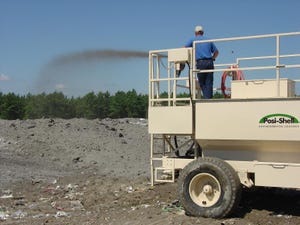 Specialized spray equipment is used to apply the spray-ons to the surface of the landfill. This forms a thin layer over the waste. Several additional applications from different directions may be needed to ensure even coverage of the waste.
Specialized spray equipment is used to apply the spray-ons to the surface of the landfill. This forms a thin layer over the waste. Several additional applications from different directions may be needed to ensure even coverage of the waste.
The biggest advantage to spray-ons is that they do not need to be removed. Left in place, they are pulverized as the next lift of waste is applied on top of them, and therefore they use up none of the landfill’s valuable airspace. Spray-ons have the added benefit of being able to include odor control agents or colors to improve the aesthetics of a site. The major disadvantage of spray-on ADCs is the additional cost of the material and the specialized equipment required to apply it. Spray-ons typically cost $.05 to $.10 per square foot of coverage per application.
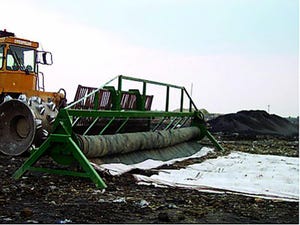 • Geosynthetic covers (tarps). Geosynthetic covers or tarps are large pieces of plastic or fabric material that are deployed by equipment or hand akin to the rain tarp placed over a baseball diamond during rain delays. The advantages of tarps include using no airspace, minimal cost, speed of deployment and removal, and the fact that they are reusable. Some of the drawbacks include the difficulty of deploying tarps (especially in windy conditions), exposure of employees to the waste, and tearing that often occurs when the tarps are dragged across the waste.
• Geosynthetic covers (tarps). Geosynthetic covers or tarps are large pieces of plastic or fabric material that are deployed by equipment or hand akin to the rain tarp placed over a baseball diamond during rain delays. The advantages of tarps include using no airspace, minimal cost, speed of deployment and removal, and the fact that they are reusable. Some of the drawbacks include the difficulty of deploying tarps (especially in windy conditions), exposure of employees to the waste, and tearing that often occurs when the tarps are dragged across the waste.
Special equipment can be used to deploy tarps. Such equipment is not required, and can be expensive both in capital and maintenance costs. However, using specialized deployment equipment improves safety, reduces the number of workers needed, and can increase the speed of placing and removing the tarp. The cost for tarps typically runs between $800 and $1,200 for a panel, and they can last from 60 to 180 days.
Advantages of ADCs
The biggest advantage of ADCs is the conservation of airspace. Landfills are in the business of selling and managing airspace. Any tool that can increase the amount of waste that can be placed in a landfill can greatly impact the bottom line of the facility.
One of the technical advantages of using ADCs relates to the management of landfill gas and leachate. Using non-waste derived ADCs means reducing the amount of soil in your landfill. This helps with landfill gas and leachate flow by removing potential barriers to their free movement within the waste. This can result in greater landfill gas generation, which in turn may also increase revenue from captured landfill gas. It can also facilitate the flow of leachate through the waste mass to the collection layer, minimizing the potential for leachate seeps that cause operational and regulatory headaches.
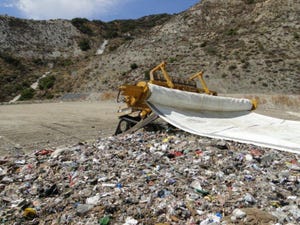 ADCs can serve as another source of revenue for a landfill, in addition to tipping fees and renewable energy from landfill gas. By getting paid to take a material instead of having to spend money on hauling on-site soil or procuring soil from off-site, landfill managers can greatly reduce operating costs and improve their bottom line.
ADCs can serve as another source of revenue for a landfill, in addition to tipping fees and renewable energy from landfill gas. By getting paid to take a material instead of having to spend money on hauling on-site soil or procuring soil from off-site, landfill managers can greatly reduce operating costs and improve their bottom line.
One note of caution for landfill managers: be careful about using ADC materials as a source of short-term cash flow, at the expense of your overall site profitability. For example, if your only way to obtain waste-derived ADCs is to lower your tipping fee for that material, then you will need to calculate whether or not the revenue you are generating vs. the airspace used is in line with what you are receiving for normal waste. If not, then you are trading cash flow for long-term profitability.
Jeffrey M. Fantell, PE, and Tom Flannagan are senior technical consultants for Richmond, Va.-based Joyce Engineering.
Related Stories
You May Also Like

